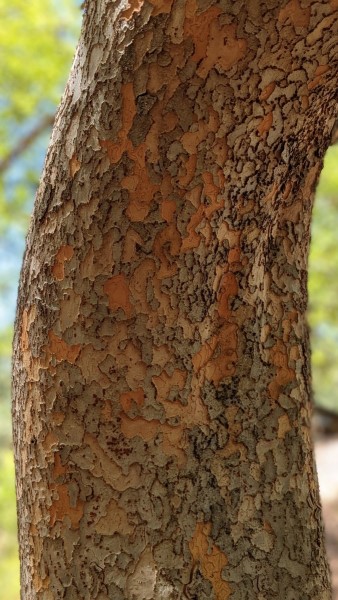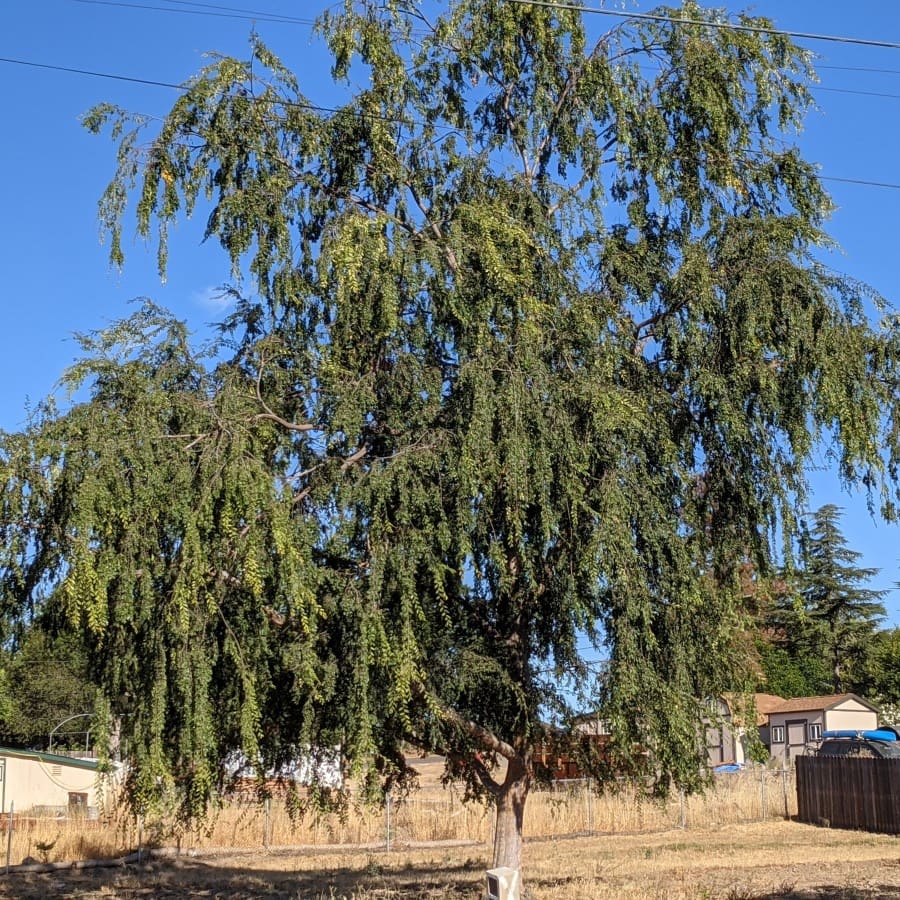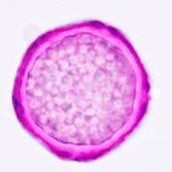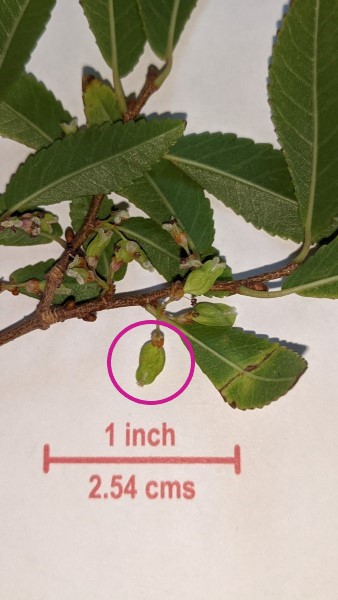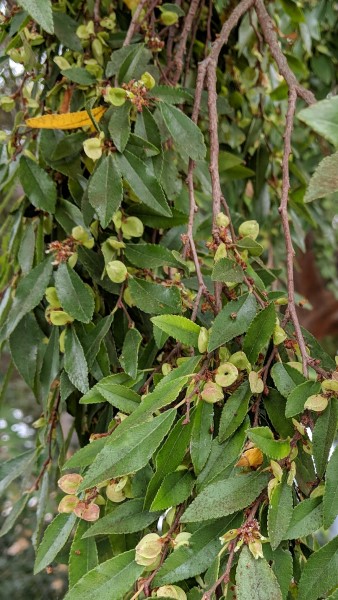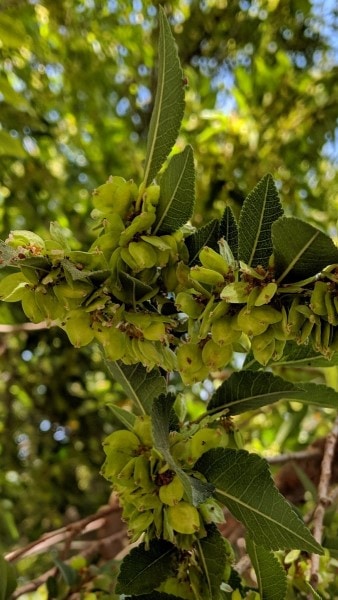In this article, with the help of photos, we will discuss Chinese elm allergies and how and when their pollen spreads.
Chinese elm allergy facts and figures
| Chinese elm (Ulmus parvifolia) | Pollen allergy profile |
|---|---|
| Pollen season | Late summer to early autumn. In the US from Aug-1st to Sep-30th. |
| Pollination type | Primarily wind transported. |
| Cross-reactivities with other pollen | Siberian Elm, American Elm, and other species of genus Ulmus |
| Pollen source | Very small inconspicuous flowers, smaller than a grain of rice, which are hard to spot in the foliage (see pictures) |
| Gender | Monoecious: The flowers are generally perfect and have both male and female parts in the same flower. |
| Bark | Chinese elm trees have beautiful, flaky golden red and grey bark (see pictures below) |
| Leaves | No more than 2 inches long, oblong, with sawtooth edges (see pictures below). |
| Fruit | Small paper-like green samaras that turn beige upon maturation (see pictures below) |
How to identify Chinese elm trees (Ulmus parvifolia)?
Chinese Elm trees are very pleasing to the eyes, that is, if you are not allergic to its pollen. It is a native of China, Japan, and Korea but is widely present in the US as a decorative tree. It is also known as lacebark elm and Drake elm[1].
Chinese elm tree, or Ulmus parvifolia, can be easily identified by its flaky golden-red and gray bark. The tree can grow 50 feet tall and its trunk can be 3 to 4 feet in diameter.
Chinese elm is a deciduous tree in colder regions but semi-deciduous in warmer climates of the western US. In this article, we will first show you how to identify a Chinese elm tree. Then, we will discuss its pollen and how it spreads.
Bark and trunk
The Chinese elm tree has flaky golden-red and gray bark. The trunk usually rises 5 to 10 feet before branching out. The diameter of the trunk of a fully grown tree is 3 to 4 feet. The tree’s beautiful bark is its most recognizable feature.
Leaves
Small leaves arrange on the twig in an alternate fashion.
The leaves are dark green in color during spring and summer serrated (saw-toothed) edges and turn yellow or orange in autumn.
The leaves are elliptical or oblate, generally, two and a half times longer than they are wide. The average size is around 2X0.8 inches or 5X2cms.
Flowers
The Chinese elm flowers are much smaller than their leaves. Therefore, they are difficult to see unless one inspects the tree twigs closely. Which is, of course, not recommended if you suffer from allergies to its pollen.
The picture shows an early bloom during the first week of August. A grain of rice is placed next to the flower as a size reference.
In the magnified picture of the flower, you can clearly see yellow anthers filled with pollen.
Size
A Chinese elm tree can grow 50 feet tall and its canopy can grow 60 feet wide[1]. Its trunk rises 5 to 10 feet before branching out.
During which months the Chinese elm trees release pollen?
Chinese elm trees release pollen during the late summer and early autumn. In general, it releases pollen between August-1st and September-30th. As per USDA, Chinese elm blooms between August and September in all states where it is present.
The pollen schedule for the Chinese elm can vary by one to two weeks each year depending on the weather and rainfall. If you live in the San Francisco Bay Area, you can get accurate pollen counts and reports on our site.
What does Chinese elm pollen look like and how does it spread?
The pollen is fine yellow powder, but airborne individual grains are invisible to the naked eye.
The pollen is wind transported. Wind can carry pollen many miles. Even if you do not have Chinese elm trees in close proximity, pollen from a nearby town can easily reach you.
Chinese elm pollen is about 25 microns in size, usually pentagonally shaped with five pores. (Ulmus parvifolia pollen: stephanoporate, does not show rugulate exine like other elms)
How to know if Chinese elm tree is releasing pollen?
A Chinese elm tree generally releases pollen for six weeks each year during summer or early fall.
The size and count of fruit on the tree are good indicators of Chinese elm allergy season and its severity.
Chinese elm tree produces small paper-like fruit, which is green in color in early development. It is harder to spot from a distance. However, it is still easier to see than inconspicuous flowers.
The fruit develops quickly from the flowers in late July to early August. Thus, the presence of small paper-like green fruit (samaras) on a tree indicates the presence of pollen-bearing flowers as well. Thus, it is fair to assume that the tree is releasing pollen into the air.
However, after six weeks, when the fruit matures, changes its color to beige, and is densely populated, the tree is most likely not releasing fresh pollen.
The tree sheds its fruit within a month of maturation, so, absence of fruit on a tree is a good sign for those who suffer from allergies to its pollen.
Where do Chinese elm trees grow in the US?
Chinese elms are beautiful decorative trees. You will find them as ornamentals or shade trees in lawns, yards, parks, city sidewalks, and campuses in California, Nevada, Arizona, Florida, Georgia, Louisiana, Arkansas, Oklahoma, Kentucky, and West Virginia. They are considered invasive to native trees in some states like Wisconsin, North Carolina, New Jersey, Virginia, Washington DC, and New England ( Maine, Connecticut, Massachusetts, New Hampshire, Rhode Island, and Vermont) [1]
Do all Chinese elm trees release pollen?
During the late summer and early autumn, when Chinese elm trees blossom, each tree will have both male and female flower parts on the same tree. The male part of the flower, Stamen, is responsible for releasing pollen. This means all healthy Chinese elm trees will produce pollen if they are mature enough to do so[4].
Final thoughts
Most people assume that pollen allergies happen during spring. And when they show symptoms in the month of August and September they get all confused. If you are one of those people who develop hay fever in late summer or early fall, the beautiful Chinese elm tree might be one of the culprits.
However, summer and fall produce some other allergens as well. Don’t forget to read about the other major allergenic plant privet that blooms during summer and early fall.
Speak with your doctor regarding a skin scratch test or blood test to confirm your allergies to Chinese elm pollen.
Sources
- https://www.invasive.org/weedcd/pdfs/wow/chinese-elm.pdf
- https://plants.usda.gov/
- https://www.ncbi.nlm.nih.gov/pmc/articles/PMC5342239/
- https://garden.org/plants/view/79367/Chinese-Elm-Ulmus-parvifolia/
References
- Allergy Plants by Mary Jelks, M.D.
- Plant identification terminology by James G. Harris and Melinda Woolf Harris (Second Edition)
All pictures, unless otherwise credited to another source, are taken by the author. We study trees and their pollen by doing regular tree inspections and air sampling. The pollen picture is taken in our aerobiology lab using an Olympus compound microscope.


